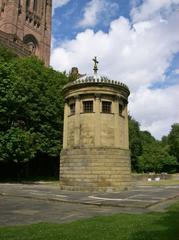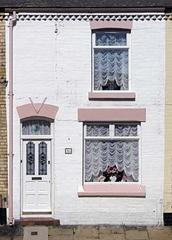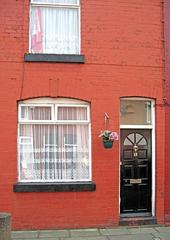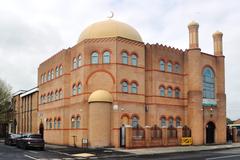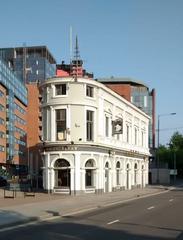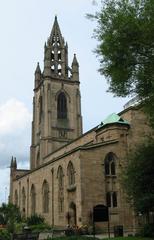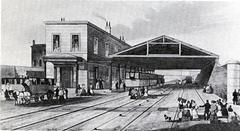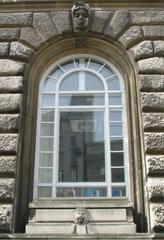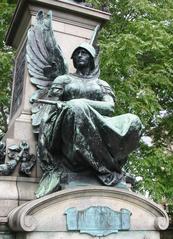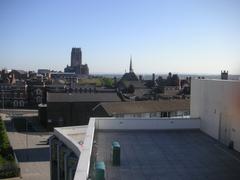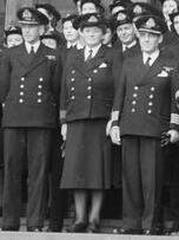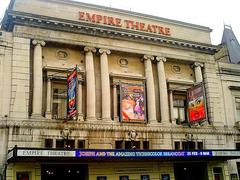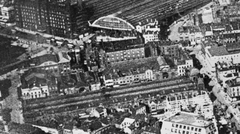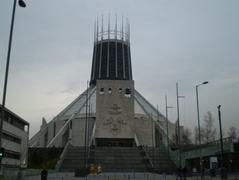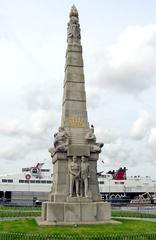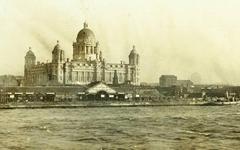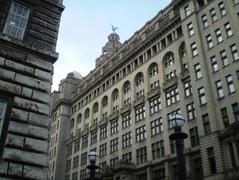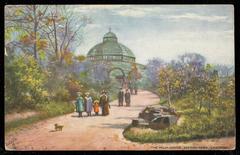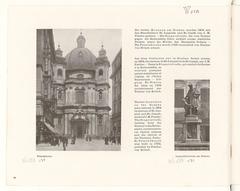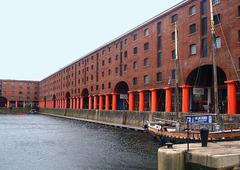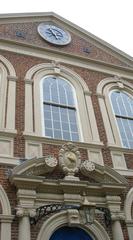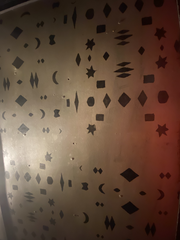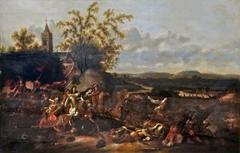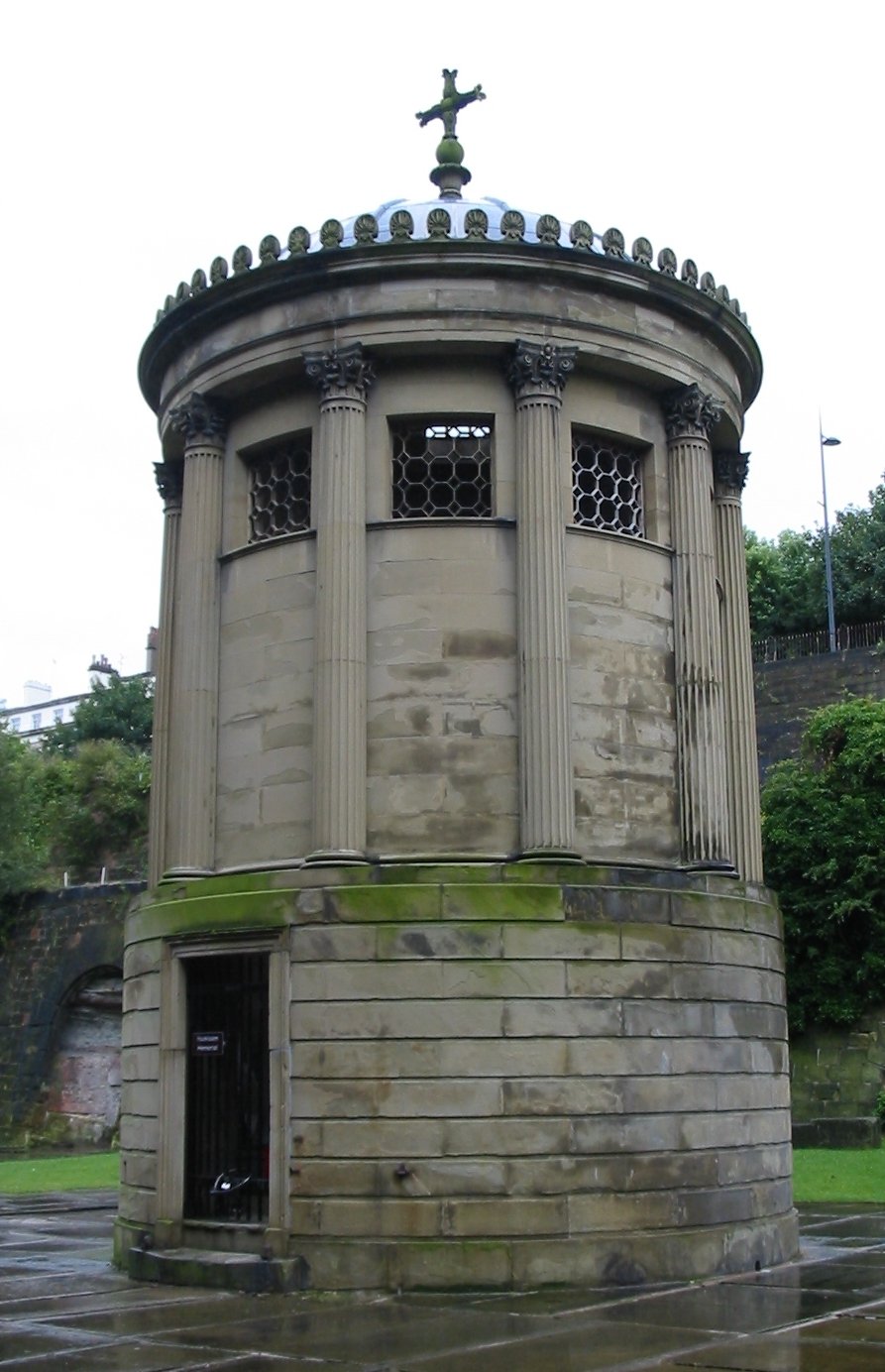
Huskisson Monument Visiting Hours, Tickets, and Liverpool Historical Sites Guide
Date: 14/06/2025
Introduction to the Huskisson Monument
The Huskisson Monument is a defining landmark within Liverpool’s Saint James’ Cemetery, standing as a testament to the city’s industrial heritage, neoclassical architectural vision, and the enduring legacy of William Huskisson (1770–1830). Huskisson, a distinguished Member of Parliament for Liverpool, was instrumental in championing free trade and parliamentary reform during the early 19th century. His tragic death during the opening of the Liverpool and Manchester Railway—becoming the first widely reported railway fatality—marked a pivotal moment in British history, highlighting both the promise and risks of the Industrial Revolution (Historic England, Amusing Planet).
The monument, designed by John Foster Jr. in the Greek Revival style and completed in 1836, not only memorializes Huskisson but also symbolizes Liverpool’s rise as a hub of innovation and civic pride. Set within the unique landscape of Saint James’ Cemetery—transformed from a former stone quarry into a tranquil sunken garden—the monument invites visitors to explore the intersection of history, architecture, and nature (LiverpoolGo).
This comprehensive guide provides essential information for planning your visit, including historical context, architectural highlights, visiting hours, accessibility, and nearby attractions. Whether you’re a history enthusiast, architecture admirer, or a traveler keen to experience Liverpool’s heritage, this resource will help you get the most from your visit. For the latest updates and event information, consult official sites like the Liverpool City Council and the Friends of St James’ Gardens.
Historical Background
The Origins of Saint James’ Cemetery
Saint James’ Cemetery was established in 1829 to provide much-needed burial space for Liverpool’s rapidly expanding population. Its setting—a former stone quarry—lends the cemetery a distinctive sunken layout, with winding paths, mature trees, and dramatic rock faces creating a peaceful sanctuary amid the city’s bustle. Nearly 58,000 people were interred here before the cemetery’s closure to new burials in 1936, making it a repository for the stories of generations of Liverpudlians (St James’ Cemetery History).
William Huskisson: Life and Legacy
William Huskisson was a reform-minded statesman known for his advocacy of free trade and economic modernization. His career was tragically cut short on 15 September 1830, when he was fatally struck by Stephenson’s Rocket during the inaugural journey of the Liverpool and Manchester Railway. This incident was widely reported and became a symbol of the era’s technological optimism and its attendant dangers (Wikipedia: William Huskisson, Amusing Planet).
Conception and Design of the Huskisson Monument
Public fundraising after Huskisson’s death led to the commissioning of a grand memorial. John Foster Jr.’s design, inspired by Greek Revival forms and modeled after the Choragic Monument of Lysicrates, features a rotunda of Corinthian columns atop a rusticated base. This classical approach communicates dignity, permanence, and Liverpool’s civic aspirations (TEP UK, Historic England).
The Statue of William Huskisson
Originally, the mausoleum housed an over-life-size marble statue of Huskisson by sculptor John Gibson. Bathed in natural light from high windows, the statue created a contemplative setting. For conservation, it was removed in 1968 and is now displayed at the Walker Art Gallery, with other versions in London and Chichester (Atlas Obscura).
Role in Liverpool’s Heritage
The Huskisson Monument is the centerpiece of Saint James’ Cemetery, emblematic of Liverpool’s self-image during the Industrial Revolution. Restoration efforts by local heritage groups have preserved it as a vital site of reflection and public memory (St James’ Cemetery History).
Architectural and Cultural Significance
As a Grade II listed structure, the monument is a rare example of Greek Revival funerary architecture in Britain and a key symbol of the city’s historical narrative (Historic England).
Architectural Design and Details
- Overall Structure: The mausoleum is a circular, domed structure of Portland stone, inspired by classical antiquity and standing on a raised platform.
- Columns: Twelve fluted Corinthian columns support the entablature and dome, creating an open, airy rotunda.
- Dome and Lantern: The dome, topped with a lantern, symbolizes eternity and allows natural light to illuminate the interior.
- Interior: The chamber originally contained a marble statue; today, it remains a contemplative space.
- Symbolism: Classical motifs and the circular form evoke ideals of democracy, virtue, and remembrance.
Setting within Saint James’ Cemetery
The monument’s location, at the heart of the sunken cemetery, makes it a focal point amid mature trees and landscaped gardens. Its prominent position allows it to be viewed from multiple angles, complementing the cemetery’s array of Victorian memorials and the dramatic backdrop of Liverpool Anglican Cathedral (Parks & Gardens UK).
Conservation and Restoration
Decades of weathering and urban pollution have necessitated periodic restoration. Recent efforts, particularly by local volunteers and heritage groups, have ensured the monument’s preservation for future generations (Historic England).
Visiting the Huskisson Monument
Visiting Hours and Tickets
- Opening Hours: Saint James’ Cemetery is open daily from 8:00 AM to dusk, though hours may vary seasonally. Always check the Liverpool City Council website for current details.
- Tickets: Entry to both the cemetery and the monument is free. Guided tours, when available, may require a modest ticket fee.
Accessibility
- The cemetery’s sunken location means access is via steps and sloped paths. While much of the main path is accessible, some areas are challenging for those with mobility impairments.
- Assistance dogs are permitted. Sturdy footwear is recommended.
Guided Tours and Events
- The Friends of St James’ Gardens and other heritage groups occasionally offer guided tours and educational events. These provide deeper historical context and access to lesser-known stories.
Photography and Best Times to Visit
- The monument’s classical lines and setting make it ideal for photography, especially in early morning or late afternoon light.
- Visitors are encouraged to be respectful of others and the memorial environment when taking photos.
Travel Tips and Nearby Facilities
- The cemetery is within walking distance of Liverpool Anglican Cathedral and the Georgian Quarter.
- Public transport links and city center parking make access straightforward.
- Nearby cafes, restrooms, and other facilities are available at the cathedral and surrounding area.
Exploring Saint James’ Cemetery: Liverpool Historical Sites Guide
History and Atmosphere
Saint James’ Cemetery is more than a burial ground; it is a living museum of Liverpool’s Victorian past. The sunken, tree-lined paths, neoclassical oratory, and array of headstones create a unique, contemplative atmosphere. The site’s egalitarian history—where the wealthy and working class rest side by side—reflects the city’s evolving social fabric (LiverpoolGo).
Paranormal Reputation
Stories of spectral sightings, such as Huskisson’s ghost or the enigmatic “woman in black,” have made the cemetery a popular destination for ghost tours and those fascinated by local legends (Only in Liverpool).
Events and Community Engagement
Local organizations host historical walks, art workshops, and seasonal ghost tours. Restoration and educational projects, often led by volunteers, continue to revitalize the cemetery’s heritage and landscape (LiverpoolGo).
Frequently Asked Questions (FAQ)
Q: What are the Huskisson Monument visiting hours?
A: The monument is open during cemetery hours, daily from 8:00 AM until dusk; check official sources for seasonal variations.
Q: Is there an entry fee?
A: No, entry is free. Some guided tours may have a small fee.
Q: Are guided tours available?
A: Yes, through local heritage groups and the Friends of St James’ Gardens; see their website for schedules.
Q: Is the site accessible for wheelchairs?
A: Main paths are accessible, but some areas are steep or uneven. Assistance may be required.
Q: Can I take photographs?
A: Yes, photography is encouraged. Please respect the dignity of the site.
Q: Are children and pets allowed?
A: Children are welcome with supervision. Pets are generally not permitted to protect the site’s integrity.
Conclusion and Visit Planning Tips
The Huskisson Monument offers a compelling journey into Liverpool’s history, combining architectural grandeur with moving personal and collective stories. Free access, proximity to other major landmarks, and the tranquil setting make it an essential stop for anyone interested in the city’s heritage.
Visitor tips:
- Check the latest opening hours and tour schedules before visiting.
- Wear comfortable footwear for the uneven terrain.
- Combine your trip with visits to Liverpool Anglican Cathedral and the Georgian Quarter.
- Respect the peaceful atmosphere and take time to reflect on the city’s past.
For more information, updates, and to book tours, visit the Liverpool City Council, Friends of St James’ Gardens, and LiverpoolGo.

